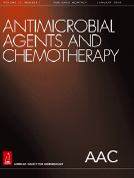Posted on May 02, 2016
Source: Antimicrobial Agents and Chemotherapy

High Systemic Exposure of Pyrazinoic Acid Has Limited Antituberculosis Activity in Murine and Rabbit Models of Tuberculosis
Lanoix JP, Tasneen R, O'Brien P, Sarathy J, Safi H, Pinn 2, Alland 4, Dartois V, Nuermberger E
Pyrazinamide (PZA) is a prodrug requiring conversion to pyrazinoic acid (POA) by an amidase encoded by pncA for in vitro activity. Mutation of pncA is the most common cause of PZA resistance in clinical isolates. To determine whether the systemic delivery of POA or host-mediated conversion of PZA to POA could circumvent such resistance, we evaluated the efficacy of orally administered and host-derived POA in vivo Dose-ranging plasma and intrapulmonary POA pharmacokinetics and the efficacy of oral POA or PZA treatment against PZA-susceptible tuberculosis were determined in BALB/c and C3HeB/FeJ mice. The activity of host-derived POA was assessed in rabbits infected with a pncA-null mutant and treated with PZA. Median plasma POA values for the area under the concentration-time curve from 0 h to infinity (AUC0-∞) were 139 to 222 μg·h/ml and 178 to 287 μg·h/ml after doses of PZA and POA of 150 mg/kg of body weight, respectively, in mice. Epithelial lining fluid POA concentrations in infected mice were comparable after POA and PZA administration. In chronically infected BALB/c mice, PZA at 150 mg/kg reduced lung CFU counts by >2 log10 after 4 weeks. POA was effective only at 450 mg/kg, which reduced lung CFU counts by ∼0.7 log10 POA had no demonstrable bactericidal activity in C3HeB/FeJ mice, nor did PZA administered to rabbits infected with a PZA-resistant mutant. Oral POA administration and host-mediated conversion of PZA to POA producing plasma POA exposures comparable to PZA administration was significantly less effective than PZA. These results suggest that the intrabacillary delivery of POA and that producing higher POA concentrations at the site of infection will be more effective strategies for maximizing POA efficacy.